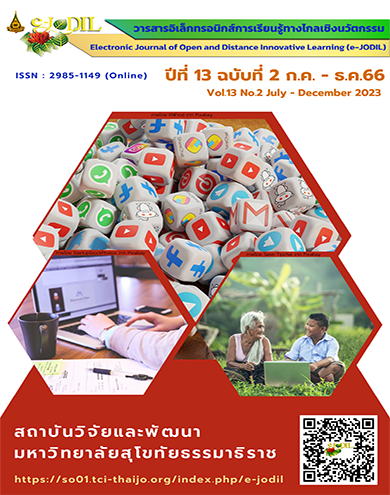โมเดลแบบผสมรูปแบบการให้บริการทางกิจกรรมบำบัดในประเทศไทยกับการประยุกต์ใช้จากการให้บริการทางกิจกรรมบำบัดนานาชาติในช่วงสถานการณ์การระบาด ของโรคติดเชื้อไวรัสโคโรนา 2019
Main Article Content
บทคัดย่อ
การศึกษานี้มีวัตถุประสงค์เพื่อศึกษาความสัมพันธ์รูปแบบการให้บริการทางกิจกรรมบำบัดในประเทศไทย (Occupational Therapy Services in Thailand: OTST) กับการประยุกต์ใช้จากการให้บริการทางกิจกรรมบำบัดนานาชาติ (Applications from International Occupational Therapy Practices: IOTP) ในช่วงสถานการณ์การระบาดของโรคติดเชื้อไวรัสโคโรนา 2019 ด้วยโมเดลแบบผสม และ ตรวจสอบความสอดคล้องของโมเดลความสัมพันธ์ ประกอบด้วย ตัวแปรรูปแบบการให้บริการที่พัฒนาขึ้น กับ ตัวแปรการประยุกต์ใช้จากการให้บริการทางกิจกรรมบำบัดนานาชาติมาใช้ โดยใช้แบบสอบถามในการเก็บข้อมูลจากกลุ่มตัวอย่างที่เป็นนักกิจกรรมบำบัดที่ให้บริการในช่วงสถานการณ์การระบาดของโรคติดเชื้อไวรัสโคโรนา 2019 จำนวน 153 คน ด้วยการสุ่มตัวอย่างแบบหลายขั้นตอน และดำเนินการวิเคราะห์ข้อมูลด้วยโปรแกรม LISREL 8.8 Student ผลการวิจัย ความสอดคล้องของโมเดลความสัมพันธ์รูปแบบการให้บริการทางกิจกรรมบำบัดในประเทศไทย กับการประยุกต์ใช้จากการให้บริการทางกิจกรรมบำบัดนานาชาติ พบว่า โมเดลมีความสอดคล้องกับข้อมูลเชิงประจักษ์ โดยมีค่า χ2 = 3.71, df = 5, p = 0.59, χ2/df = 0.97; RMSEA =0.00; SRMR= 0.05; GFI= 0.97; AGFI=0.94 รวมทั้ง ตัวแปรรูปแบบการให้บริการทางกิจกรรมบำบัดในประเทศไทย ยังส่งผลต่อการประยุกต์ใช้จากการให้บริการทางกิจกรรมบำบัดนานาชาติ เท่ากับ 0.24 อย่างมีนัยสำคัญทางสถิติที่ระดับ 0.05 ซึ่งทั้งสองผลลัพธ์นี้สะท้อนกลยุทธ์การเรียนรู้และการพัฒนาสำหรับเทคโนโลยีระดับต้น-กลาง-สูง การประยุกต์ที่ยั่งยืนจากแนวทางนานาชาติให้โอกาสการบริการสาธารณสุขทางไกลและการอบรมออนไลน์สำหรับกิจกรรมบำบัดในประเทศไทย อันมีความหมายสู่การทดสอบประสิทธิผลของการให้บริการทางกิจกรรมบำบัดอิงกิจกรรมรูปแบบการดำเนินชีวิตบนฐานวิถีชีวิตใหม่
Downloads
Article Details

อนุญาตภายใต้เงื่อนไข Creative Commons Attribution-NonCommercial-NoDerivatives 4.0 International License.
บทความ ข้อความ ภาพประกอบ ตารางประกอบ ที่ตีพิมพ์ในวารสารเป็นความคิดเห็นและความรับผิดชอบของผู้เขียนแต่เพียงผู้เดียว ไม่เกี่ยวข้องกับมหาวิทยาลัยสุโขทัยธรรมาธิราชแต่อย่างใด
บทความที่เสนอพิจารณาในวารสาร e-JODIL ต้องเป็นบทความที่ไม่เคยส่งไปลงพิมพ์ เผยแพร่ หรืออยู่ระหว่างการพิจารณาของวารสารอื่น
กองบรรณาธิการขอสงวนสิทธิ์ในการพิจารณาและตัดสินการตีพิมพ์บทความในวารสาร
เอกสารอ้างอิง
American Occupational Therapy Association. (2018). Telehealth in Occupational Therapy. The American Journal of Occupational Therapy, 72 (Supplement_2), 7212410059p1–7212410059p18. https://doi.org/10.5014/ajot.2018.72S219
Brown, T. (2021). The Response to COVID‐19: Occupational Resilience and the Resilience of Daily Occupations in Action. Australian Occupational Therapy Journal, 68(2), 103-105.
Camden, C., & Silva, M. (2021). Pediatric Teleheath: Opportunities Created by the COVID-19 and Suggestions to Sustain Its Use to Support Families of Children with Disabilities. Physical & Occupational Therapy in Pediatrics, 41(1), 1-17.
Cason, J. (2015). Telehealth and Occupational Therapy: Integral to the Triple Aim of Health Care Reform. The American Journal of Occupational Therapy, 69(2), 6902090010p1-6902090010p8.
Department of Medical Services. (2019). Practice Guideline for Adapt Rehabilitation Services in COVID-19. Retrieved August 18, 2021, from http://www.sbo.moph.go.th/sbo/file/eoc/corona/case%20management/CM_newnormal/
Dirette, D. (2020). Occupational Therapy in the Time of COVID-19. The Open Journal of Occupational Therapy, 8(4), 1–4. https://doi.org/10.15453/2168-6408.1794.
Kalaya Rajanagarindra Institute, Department of Mental Health. (2021). Guide to Remote Psychiatric Screening Services (Telepsychiatry) Outpatient for the Department of Mental Health Ministry of Health. Retrieved September 18, 2021, from https://dmhelibrary.org/files/original/c4282d306bf5e3966ff756554d4461f8.pdf.
Kamalakannan, S., & Chakraborty, S. (2020). Occupational Therapy: The Key to Unlocking Locked-up Occupations During the COVID-19 Pandemic. Wellcome Open Research, 5, 153.
Keptner, K. M., & McCarthy, K. (2020). Disruption of Academic Occupations During COVID-19: Impact on Mental Health and the Role of Occupational Therapy in Tertiary Education. World Federation of Occupational Therapists Bulletin, 76(2), 78-81.
Muthén, L.K., & Muthén, B.O. (2010). Mplus: Statistical Analysis with Latent Variables User’s Guide (Version 6). Los Angeles, CA.: Muthén & Muthén
Mynard, L. (2020). Normal Life Has Been Disrupted: Managing the Disruption Caused by COVID-19. Retrieved from https://bit.ly/2Ulksxz.
Polit, D.F., & Beck, C.T. (2004). Nursing Research: Principles and Methods. Philadelphia: Lippincott Williams & Wilkins.
Priyadharsini, H., & Chiang, J.J. (2020). Embracing Telehealth: Supporting Young Children and Families Through Occupational Therapy in Singapore During COVID-19. World Federation of Occupational Therapists Bulletin, 76(2), 90-93.
Professional Committee in Occupational Therapy. (2011). Professional Standards for the Art of Healing in Occupational Therapy. Bangkok: Ministry of Public Health, Department of Health Service Support, Bureau of Sanatorium and Art of Healing.
Ricci, É.C., Dimov, T., da Silva Cassais, T., & Dellbrügger, A.P. (2020). University Experiences of Occupational Therapy in Brazil During the Covid-19 Pandemic: Contributions and Support in Mental Health for the Population. World Federation of Occupational Therapists Bulletin, 76(2), 75-77.
Robinson, M.R., Koverman, B., Becker, C., Ciancio, K.E., Fisher, G., & Saake, S. (2021). Lessons Learned from the COVID-19 Pandemic: Occupational Therapy on the Front Line. The American Journal of Occupational Therapy, 75(2).
Shumacker, R.E., & Lomax, R.G. (2010). A Beginner's Guide to Structural Equation Modeling. New York: Routledge Taylor and Francis Group, LLC.
Sinclair, K. (2021). Occupational Therapy and COVID-19. World Federation of Occupational Therapists Bulletin, 77(1), 1-2.
Srivastava, A.K., Mishra, N., & Sethuraman, L. (2020). Covid-19 Pandemic: The All India Occupational Therapists’ Association’s Response to the Challenges. World Federation of Occupational Therapists Bulletin, 76(2), 98-102.
Sterrenberg, K. (2022). A Virtual Group Program to Improve Quality of Life for People Living with Parkinson’s: an Australian Response to the COVID-19 Pandemic. World Federation of Occupational Therapists Bulletin, 78(1), 53-58.
Sy, M.P., Pineda, R.C.S., Yao, D.P.G., Guevara, C.A.L., Delos Reyes, R.C., & Castro, I.M. (2020). Shared Voices of Filipino Occupational Therapists During the COVID-19 Pandemic: Reflections from an Online Forum. World Federation of Occupational Therapists Bulletin, 76(1), 60-64.
Teoh, J.Y. (2021). Population-Level Public Mental Health Intervention Via Interdisciplinary COVID-19 Health Crisis Communication: How Can Occupational Therapists Contribute?. World Federation of Occupational Therapists Bulletin, 77(1), 10-15.
Waltz, C.F., Strickland, O.L., & Lenz, E.R. (2005). Measurement in Nursing and Health Research (3rd ed.). New York: Springer Publishing Co.
World Federation of Occupational Therapists. (2020). Public Statement: Occupational Therapy Response to the COVID-19 Pandemic.Retrieved from https://www.wfot.org/about/public-statement-occupational-therapy-response-to-the-covid-19-pandemic.
World Health Organization. (2010). Telemedicine: Opportunities and Developments in Member States. Report on the Second Global Survey on eHealth. World Health Organization.


